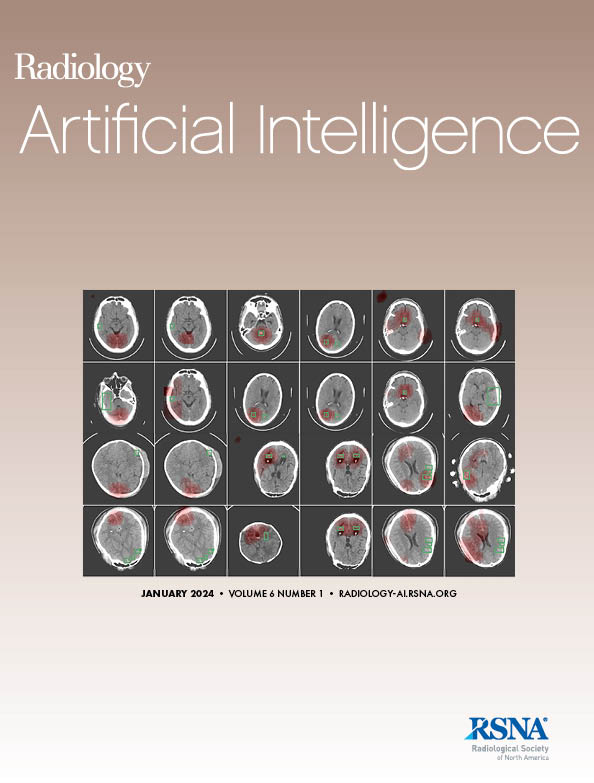Johannes Thalhammer, Manuel Schultheiß, Tina Dorosti, Tobias Lasser, Franz Pfeiffer, Daniela Pfeiffer, Florian Schaff
下载PDF
{"title":"通过基于 U-Net 的伪影消除技术改进稀疏视图 CT 中的出血自动检测功能","authors":"Johannes Thalhammer, Manuel Schultheiß, Tina Dorosti, Tobias Lasser, Franz Pfeiffer, Daniela Pfeiffer, Florian Schaff","doi":"10.1148/ryai.230275","DOIUrl":null,"url":null,"abstract":"<p><p>Purpose To explore the potential benefits of deep learning-based artifact reduction in sparse-view cranial CT scans and its impact on automated hemorrhage detection. Materials and Methods In this retrospective study, a U-Net was trained for artifact reduction on simulated sparse-view cranial CT scans in 3000 patients, obtained from a public dataset and reconstructed with varying sparse-view levels. Additionally, EfficientNet-B2 was trained on full-view CT data from 17 545 patients for automated hemorrhage detection. Detection performance was evaluated using the area under the receiver operating characteristic curve (AUC), with differences assessed using the DeLong test, along with confusion matrices. A total variation (TV) postprocessing approach, commonly applied to sparse-view CT, served as the basis for comparison. A Bonferroni-corrected significance level of .001/6 = .00017 was used to accommodate for multiple hypotheses testing. Results Images with U-Net postprocessing were better than unprocessed and TV-processed images with respect to image quality and automated hemorrhage detection. With U-Net postprocessing, the number of views could be reduced from 4096 (AUC: 0.97 [95% CI: 0.97, 0.98]) to 512 (0.97 [95% CI: 0.97, 0.98], <i>P</i> < .00017) and to 256 views (0.97 [95% CI: 0.96, 0.97], <i>P</i> < .00017) with a minimal decrease in hemorrhage detection performance. This was accompanied by mean structural similarity index measure increases of 0.0210 (95% CI: 0.0210, 0.0211) and 0.0560 (95% CI: 0.0559, 0.0560) relative to unprocessed images. Conclusion U-Net-based artifact reduction substantially enhanced automated hemorrhage detection in sparse-view cranial CT scans. <b>Keywords:</b> CT, Head/Neck, Hemorrhage, Diagnosis, Supervised Learning <i>Supplemental material is available for this article.</i> © RSNA, 2024.</p>","PeriodicalId":29787,"journal":{"name":"Radiology-Artificial Intelligence","volume":" ","pages":"e230275"},"PeriodicalIF":8.1000,"publicationDate":"2024-07-01","publicationTypes":"Journal Article","fieldsOfStudy":null,"isOpenAccess":false,"openAccessPdf":"https://www.ncbi.nlm.nih.gov/pmc/articles/PMC11294955/pdf/","citationCount":"0","resultStr":"{\"title\":\"Improving Automated Hemorrhage Detection at Sparse-View CT via U-Net-based Artifact Reduction.\",\"authors\":\"Johannes Thalhammer, Manuel Schultheiß, Tina Dorosti, Tobias Lasser, Franz Pfeiffer, Daniela Pfeiffer, Florian Schaff\",\"doi\":\"10.1148/ryai.230275\",\"DOIUrl\":null,\"url\":null,\"abstract\":\"<p><p>Purpose To explore the potential benefits of deep learning-based artifact reduction in sparse-view cranial CT scans and its impact on automated hemorrhage detection. Materials and Methods In this retrospective study, a U-Net was trained for artifact reduction on simulated sparse-view cranial CT scans in 3000 patients, obtained from a public dataset and reconstructed with varying sparse-view levels. Additionally, EfficientNet-B2 was trained on full-view CT data from 17 545 patients for automated hemorrhage detection. Detection performance was evaluated using the area under the receiver operating characteristic curve (AUC), with differences assessed using the DeLong test, along with confusion matrices. A total variation (TV) postprocessing approach, commonly applied to sparse-view CT, served as the basis for comparison. A Bonferroni-corrected significance level of .001/6 = .00017 was used to accommodate for multiple hypotheses testing. Results Images with U-Net postprocessing were better than unprocessed and TV-processed images with respect to image quality and automated hemorrhage detection. With U-Net postprocessing, the number of views could be reduced from 4096 (AUC: 0.97 [95% CI: 0.97, 0.98]) to 512 (0.97 [95% CI: 0.97, 0.98], <i>P</i> < .00017) and to 256 views (0.97 [95% CI: 0.96, 0.97], <i>P</i> < .00017) with a minimal decrease in hemorrhage detection performance. This was accompanied by mean structural similarity index measure increases of 0.0210 (95% CI: 0.0210, 0.0211) and 0.0560 (95% CI: 0.0559, 0.0560) relative to unprocessed images. Conclusion U-Net-based artifact reduction substantially enhanced automated hemorrhage detection in sparse-view cranial CT scans. <b>Keywords:</b> CT, Head/Neck, Hemorrhage, Diagnosis, Supervised Learning <i>Supplemental material is available for this article.</i> © RSNA, 2024.</p>\",\"PeriodicalId\":29787,\"journal\":{\"name\":\"Radiology-Artificial Intelligence\",\"volume\":\" \",\"pages\":\"e230275\"},\"PeriodicalIF\":8.1000,\"publicationDate\":\"2024-07-01\",\"publicationTypes\":\"Journal Article\",\"fieldsOfStudy\":null,\"isOpenAccess\":false,\"openAccessPdf\":\"https://www.ncbi.nlm.nih.gov/pmc/articles/PMC11294955/pdf/\",\"citationCount\":\"0\",\"resultStr\":null,\"platform\":\"Semanticscholar\",\"paperid\":null,\"PeriodicalName\":\"Radiology-Artificial Intelligence\",\"FirstCategoryId\":\"1085\",\"ListUrlMain\":\"https://doi.org/10.1148/ryai.230275\",\"RegionNum\":0,\"RegionCategory\":null,\"ArticlePicture\":[],\"TitleCN\":null,\"AbstractTextCN\":null,\"PMCID\":null,\"EPubDate\":\"\",\"PubModel\":\"\",\"JCR\":\"Q1\",\"JCRName\":\"COMPUTER SCIENCE, ARTIFICIAL INTELLIGENCE\",\"Score\":null,\"Total\":0}","platform":"Semanticscholar","paperid":null,"PeriodicalName":"Radiology-Artificial Intelligence","FirstCategoryId":"1085","ListUrlMain":"https://doi.org/10.1148/ryai.230275","RegionNum":0,"RegionCategory":null,"ArticlePicture":[],"TitleCN":null,"AbstractTextCN":null,"PMCID":null,"EPubDate":"","PubModel":"","JCR":"Q1","JCRName":"COMPUTER SCIENCE, ARTIFICIAL INTELLIGENCE","Score":null,"Total":0}
引用次数: 0
引用
批量引用

 求助内容:
求助内容: 应助结果提醒方式:
应助结果提醒方式:


